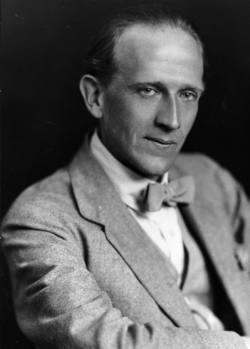
A. A. Milne was born in Kilburn, London, to parents Vince Milne, who was Scottish, and Sarah Marie Milne (née Heginbotham) and grew up at Henley House School, 6/7 Mortimer Road (now Crescent), Kilburn, a small public school run by his father. One of his teachers was H. G. Wells who taught there in 1889–90. Milne attended Westminster School and Trinity College, Cambridge, where he studied on a mathematics scholarship. While there, he edited and wrote for Granta, a student magazine. He collaborated with his brother Kenneth and their articles appeared over the initials AKM. Milne's work came to the attention of the leading British humour magazine Punch, where Milne was to become a contributor and later an assistant editor.
Milne is most famous for his two Pooh books about a boy named Christopher Robin after his son, Christopher Robin Milne, and various characters inspired by his son's stuffed animals, most notably the bear named Winnie-the-Pooh. Christopher Robin Milne's stuffed bear, originally named "Edward", was renamed "Winnie-the-Pooh" after a Canadian black bear named Winnie (after Winnipeg), which was used as a military mascot in World War I, and left to London Zoo during the war. "The pooh" comes from a swan called "Pooh". E. H. Shepard illustrated the original Pooh books, using his own son's teddy, Growler ("a magnificent bear"), as the model. Other notable characters created by Milne include the bouncy Tigger and gloomy Eeyore. Christopher Robin Milne's own toys are now under glass in New York.
